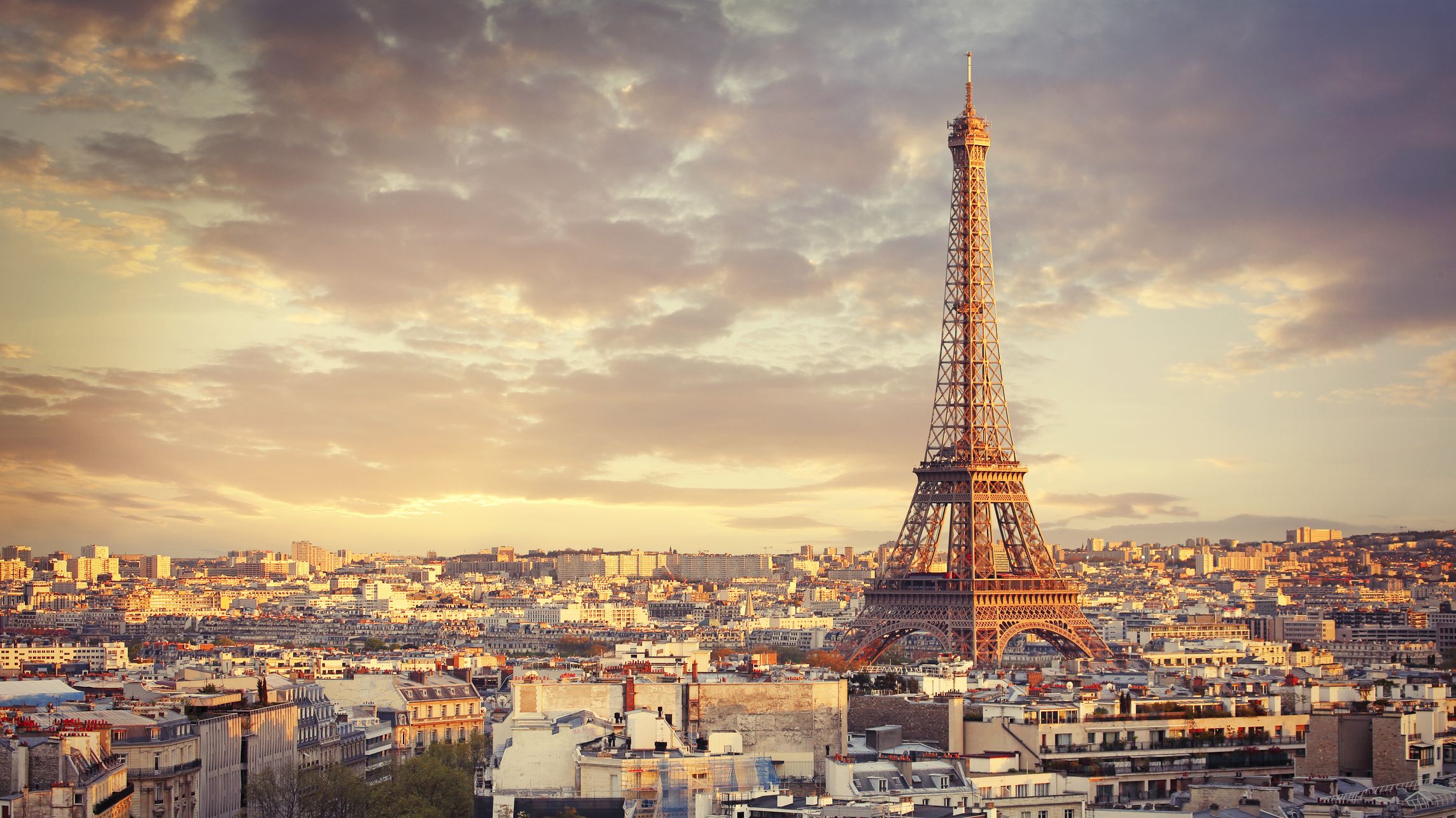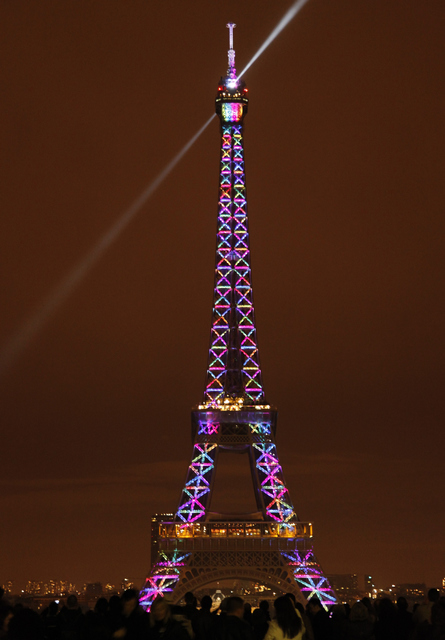Paris Eiffel Tower -- HISTORY

Eiffel Tower history : the beginning
The most popular tourist place in Paris has stretched to the Parisian skies for 127 years. Although now symbolic of France, it wasn’t meant to last. Without a doubt, the turning point in the Eiffel Tower history took place at the 1889 Universal Exposition. In commemoration of the 100th anniversary of the French Revolution, a competition was organized with the aim to “build on the Champ-de-Mars an iron tower with a square base, 125 meters wide and 300 meters high.” Out of the 107 proposals submitted,Gustave Eiffel’s was chosen. By his side were engineers Maurice Koechlin and Emile Nouguier as well as architect Stephen Sauvestre.

The Iron Lady facing skepticism
The Eiffel Tower history was not an easy one. At the time, many were against the building and voiced their concern in a letter entitled "Artists Against Mr. Eiffel’s Tower", stating the tower to be a threat against the aesthetic nature of Paris. An iron tower erected smack in the heart of Paris was considered unacceptable, a stark contrast to the elegance and refined beauty of the city. For example, Verlaine nicknamed the Eiffel Tower the “Skeleton of Beffroi” to demonstrate the giant tower’s ungainly appearance that was bound to “disfigure” the city.
The history of the construction of the Eiffel Tower (1887- 1889)
Despite all the uproar, the frail iron tower would nonetheless see the day. To understand the history of the Eiffel Tower, it is important to know that its construction followed different steps. The construction itself lasted two years.
- June 1884 : The project began and the first drawings were done.
- January 28th, 1887 : The works begin.
- April 1st, 1888 : The first stage was completed.
- August 14th, 1888 : The second stage was completed.
- March 31st, 1889 : The third and final stage in which the tower was completed in its entirety ended.
- The Eiffel Tower was inaugurated on March 31, 1889. Gustave Eiffel walked the 1,710 steps to the top of the Tower to place the tricolored French flag at its summit. At the time, the Tower was 312 meters high.
Story of a temporary building turned into a French symbol
When the project came to being, it had been established that the licensing rights linked to the convention for the tower’s construction would last only 20 years, followed by imminent destruction. However, two million people visited the Tower during the Universal Exposition. Following this incredible success, the building became a symbol of French industrial power. The Tower was as equally as successful during the 1900 Universal Exposition. Determined to avoid the Tower’s destruction, Gustave Eiffel went to great lengths to prove its scientific utility. Scientific experiments were conducted in the fields of astronomy and physiology but what would really save the Tower in the end was its use as a radio antenna tower, first for military communications and then for permanent, radiotelegraphy communications; in fact, the Tower served many a purpose during the First World War. The Eiffel Tower is part of the French History.
.
When Gustave Eiffel’s company built Paris’ most recognizable monument for the 1889 World’s Fair, many regarded the massive iron structure with skepticism. Today, the Eiffel Tower, which continues to serve an important role in television and radio broadcasts, is considered an architectural wonder and attracts more visitors than any other paid tourist attraction in the world.
Designing and Building the Eiffel Tower
In 1889, Paris hosted an Exposition Universelle (World’s Fair) to mark the 100-year anniversary of the French Revolution. More than 100 artists submitted competing plans for a monument to be built on the Champ-de-Mars, located in central Paris, and serve as the exposition’s entrance. The commission was granted to Eiffel et Compagnie, a consulting and construction firm owned by the acclaimed bridge builder, architect and metals expert Alexandre-Gustave Eiffel. While Eiffel himself often receives full credit for the monument that bears his name, it was one of his employees—a structural engineer named Maurice Koechlin—who came up with and fine-tuned the concept. Several years earlier, the pair had collaborated on the Statue of Liberty’s metal armature.
Eiffel reportedly rejected Koechlin’s original plan for the tower, instructing him to add more ornate flourishes. The final design called for more than 18,000 pieces of puddle iron, a type of wrought iron used in construction, and 2.5 million rivets. Several hundred workers spent two years assembling the framework of the iconic lattice tower, which at its inauguration in March 1889 stood nearly 1,000 feet high and was the tallest structure in the world—a distinction it held until the completion of New York City’s Chrysler Building in 1930. (In 1957, an antenna was added that increased the structure’s height by 65 feet, making it taller than the Chrysler Building but not the Empire State Building, which had surpassed its neighbor in 1931.) Initially, only the Eiffel Tower’s second-floor platform was open to the public; later, all three levels, two of which now feature restaurants, would be reachable by stairway or one of eight elevators.
Millions of visitors during and after the World’s Fair marveled at Paris’ newly erected architectural wonder. Not all of the city’s inhabitants were as enthusiastic, however: Many Parisians either feared it was structurally unsound or considered it an eyesore. The novelist Guy de Maupassant, for example, allegedly hated the tower so much that he often ate lunch in the restaurant at its base, the only vantage point from which he could completely avoid glimpsing its looming silhouette.

The Eiffel Tower Becomes a Permanent Feature of the Paris Skyline
Originally intended as a temporary exhibit, the Eiffel Tower was almost torn down and scrapped in 1909. City officials opted to save it after recognizing its value as a radiotelegraph station. Several years later, during world war 1, the Eiffel Tower intercepted enemy radio communications, relayed zeppelin alerts and was used to dispatch emergency troop reinforcements. It escaped destruction a second time during world war 2 : Hitler initially ordered the demolition of the city’s most cherished symbol, but the command was never carried out. Also during the German occupation of Paris, French resistance fighters famously cut the Eiffel Tower’s elevator cables so that the Nazis had to climb the stairs.
Over the years, the Eiffel Tower has been the site of numerous high-profile stunts, ceremonial events and even scientific experiments. In 1911, for instance, the German physicist Theodor Wulf used an electrometer to detect higher levels of radiation at its top than at its base, observing the effects of what are now called cosmic rays. The Eiffel Tower has also inspired more than 30 replicas and similar structures in various cities around the world.
Now one of the most recognizable structures on the planet, the Eiffel Tower underwent a major facelift in 1986 and is repainted every seven years. It welcomes more visitors than any other paid monument in the world—an estimated 7 million people per year. Some 500 employees are responsible for its daily operations, working in its restaurants, manning its elevators, ensuring its security and directing the eager crowds flocking the tower’s platforms to enjoy panoramic views of the City of Lights.
The success story of the Eiffel Tower
Every year approximately 7 million visitors climb the Tower.
Its success is such that many countries all over the world have replicated the Tower more or less identically to the original one. Can you really imagine Paris without the Eiffel Tower? During your stay in Paris, don't miss the Eiffel Tower light shows that have been delighting the tourists and Parisians since the end of the XIXth century.





No comments